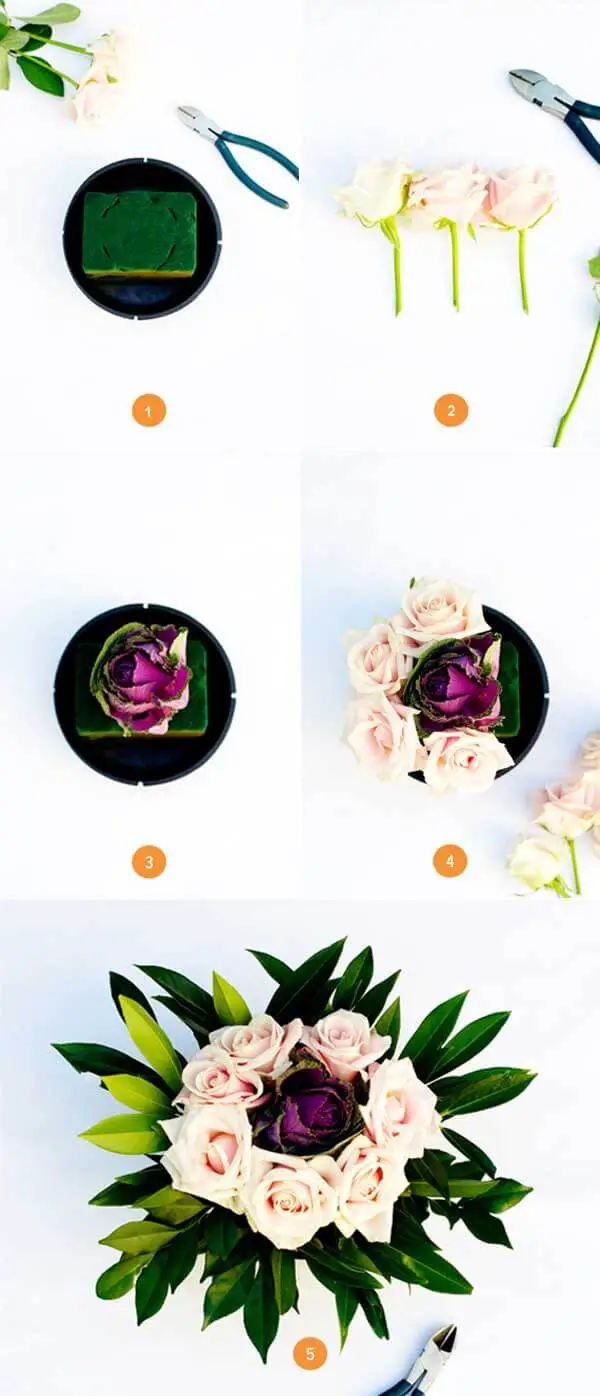30+ Different Types Of Peonies Tree, Itoh, And Herbaceous (With Pictures And Care Guide)
Peonies, with their delicate yet regal appearance, have captured the hearts of many. Native to Asia, western North America, and southern Europe, these stunning flowers are a popular choice for cut arrangements and bouquets. But beyond their beauty, peonies also offer a rich tapestry of varieties, colors, and meanings. In this article, we’ll delve into the world of peonies, exploring the different types, colors, and symbolism behind these enchanting blooms.
Facts about peony
While it’s exciting to explore the various types of peonies, let’s first take a step back and appreciate some fascinating facts about these stunning flowers. For instance, the white peony has been a staple in traditional Chinese herbal medicine for centuries, where it’s used to treat convulsions – a testament to its impressive healing properties. But that’s not all; peonies are also known for their incredible size, with some varieties boasting flower diameters of up to 10cm!
Additionally, the peony holds a special place in many cultures, serving as the state flower of Indiana and the floral symbol of China. And did you know that it’s also a popular choice for representing 12th year wedding anniversaries? Peonies are not only beautiful but also resilient – they can thrive with the right care, thanks to the benefits of potassium-rich fertilizers, which help keep them disease-resistant.
With over 35 different species, peonies boast an incredible range of colors, excluding only blue from their palette. But what’s perhaps most remarkable about these flowers is their ability to live for up to a hundred years – a true testament to their hardiness! And as if that weren’t enough, they also have the unique distinction of being particularly attractive to ants, who seem drawn to their sweet nectar.
With all these interesting facts in mind, it’s no wonder why peonies continue to captivate our hearts and imaginations.
What type of peonies are there?
While there’s only one species of peony, they’re often classified into three main types: tree peonies, herbaceous peonies, and intersectional or Itoh peonies. One key aspect that sets these categories apart is their adaptability to different climates. Herbaceous peonies are particularly well-suited for colder regions, where they’ll thrive despite the chill. In contrast, tree peonies are more sensitive to cold temperatures and will go dormant during winter months.
Intersectional or Itoh peonies, meanwhile, boast a remarkable hardiness and drought tolerance. While they may still experience some die-back during winter, their resilience allows them to flourish in a range of environments.
How many different colors of peonies are there?
Peonies are renowned for their vibrant color palette, boasting an impressive range of hues. In fact, there are 15 distinct colors to explore, each with its unique charm. These colors include the bold and fiery tones like red, which is exemplified by varieties such as Rubra Plena, Karl Rosenfeld, and Lady in Red.
On the other end of the spectrum, we find soft and delicate shades like white, represented by Immaculate and Festiva Maxima, while pink hues are showcased through Paula Fay, Benjamin Franklin, and Delicate Rose. A touch of warmth is added with blush tones, as seen in Shirley Temple, before giving way to coral-inspired varieties like Coral Sunset and Coral Charm. Yellow peonies shine bright with Bartzella and Huang Hua Kai, while purple is represented by Gui Fu.
The lavender range is comprised of Kirinmaru, while orange tones are exemplified by Copper Kettle. For a truly unique touch, bicolor peonies offer the Sorbet variety. Rounding out the palette are green, black, and even a few surprises.
Peony meaning and symbolism
Peonies are steeped in symbolic significance across cultures and traditions. The flower’s name itself is rooted in ancient Greek mythology, with Paeon, the god of medicine, serving as inspiration for its Latin designation, Paonia. This connection to medicine holds true to this day, with peonies being used to treat ailments such as migraine and asthma.
Furthermore, the flowers’ symbolic meaning varies depending on their color, with pink peonies representing the 12th wedding anniversary and white peonies tied to childbirth and femininity. In Europe, the peony is also known as the imperial flower, a title earned after Roman legions introduced it to England in the 13th century. During the Victorian era, peonies took on a new significance, symbolizing a love that’s been won, purity, and chastity.
It was during this time that the tradition of incorporating peonies into wedding arrangements began. In some cultures, like those of Serbia, peonies hold a special place in folklore and magic. Believers use the flowers as ingredients in love spells, while also employing their roots as protective charms for newborns, convinced that they’ll ward off evil. Ultimately, the peony’s broader symbolism encompasses honor, romance, beauty, purity, abundance, and more.
Tree Peonies
What are tree peonies?
Tree peonies are remarkable plants that can reach impressive heights of up to 7ft tall. Originating from China, these woody shrubs showcase a unique combination of deep green foliage during spring and summer, which gradually transitions to vibrant hues of purple and bronze as fall sets in. One notable feature is the striking flowers they produce, measuring around 7-10cm in diameter.
It’s essential to note that once the roots have established themselves, tree peonies are not tolerant of frequent relocations.
How many varieties of Tree Peonies are there?
With over 20 distinct varieties to choose from, tree peonies are renowned for their robust stems, which thrive when basking in full sunlight and well-hydrated soil conditions. The following list highlights some of these diverse species, showcasing the unique characteristics that set each apart.
Tree Peony ‘Age of Gold’

The ‘Saunders’ Peony’, alternatively known as one of the earliest American peony varieties, boasts stunning blooms featuring prominent white petals with a subtle yellow undertone. The flower’s crowning glory is its vibrant red stamen base and bright yellow anthers, adding a pop of color to its overall appearance.
Tree Peony ‘Bird of Rimpo’ (Paeonia × suffruticosa ‘Bird of Rimpo’)

The passionflower’s striking appearance is characterized by its showy, double-bloomed flowers that boast a rich, ruby-red hue. The petals’ deep purple edges and bright yellow or white anthers create a visually stunning effect. When the flower reaches maturity, the delicate glass-like texture of the petals becomes apparent, adding an extra layer of elegance to this already captivating bloom.
Tree Peony ‘Black Pirate’
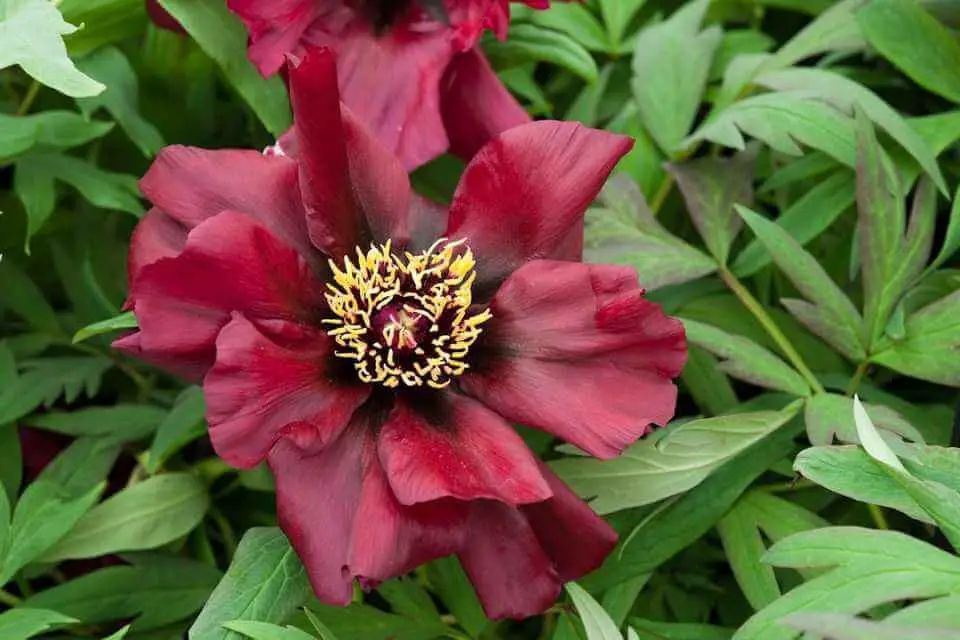
The ‘Tree Peony’ boasts an impressive display of showy, dark burgundy blooms that stand out against a backdrop of lush, apple-green foliage. A unique aspect of this variety is its delicate, yellow stamens at the center of each flower. Its popularity as one of the most beloved spring peonies speaks to its enduring appeal.
Tree Peony ‘Captain’s Concubine’

Upon closer inspection, this plant appears to be akin to delicate butterfly wings, its beauty only rivalled by its relationship to Companion of Serenity, sharing a common breeder. The plant’s most striking feature is its showy display of large, creamy white flowers, with deep pink hues at their center, adding a pop of vibrancy to any surroundings.
Tree Peony ‘Chinese Dragon’ (Paeonia suffruticosa)

This stunning plant boasts a unique growing habit, characterized by delicate and intricate knitting patterns. Its striking foliage is comprised of lacy, bronzy leaves that add a touch of elegance to any setting. Furthermore, it produces showy flowers with large, curved guard petals and long, sunny yellow anthers that can’t help but catch the eye.
Tree Peony ‘Companion of Serenity’

The ‘William Gratwick III’ tree peony is a notable cultivar, specifically bred for its unique characteristics. As an early spring bloomer, it produces a solitary bloom that stands out with its large, white petals and subtle pink streaks. The flower’s center boasts a vibrant red hue, while the anthers add a pop of color with their flashy yellow-purple tint.
Tree Peony ‘Duchess of Kent’
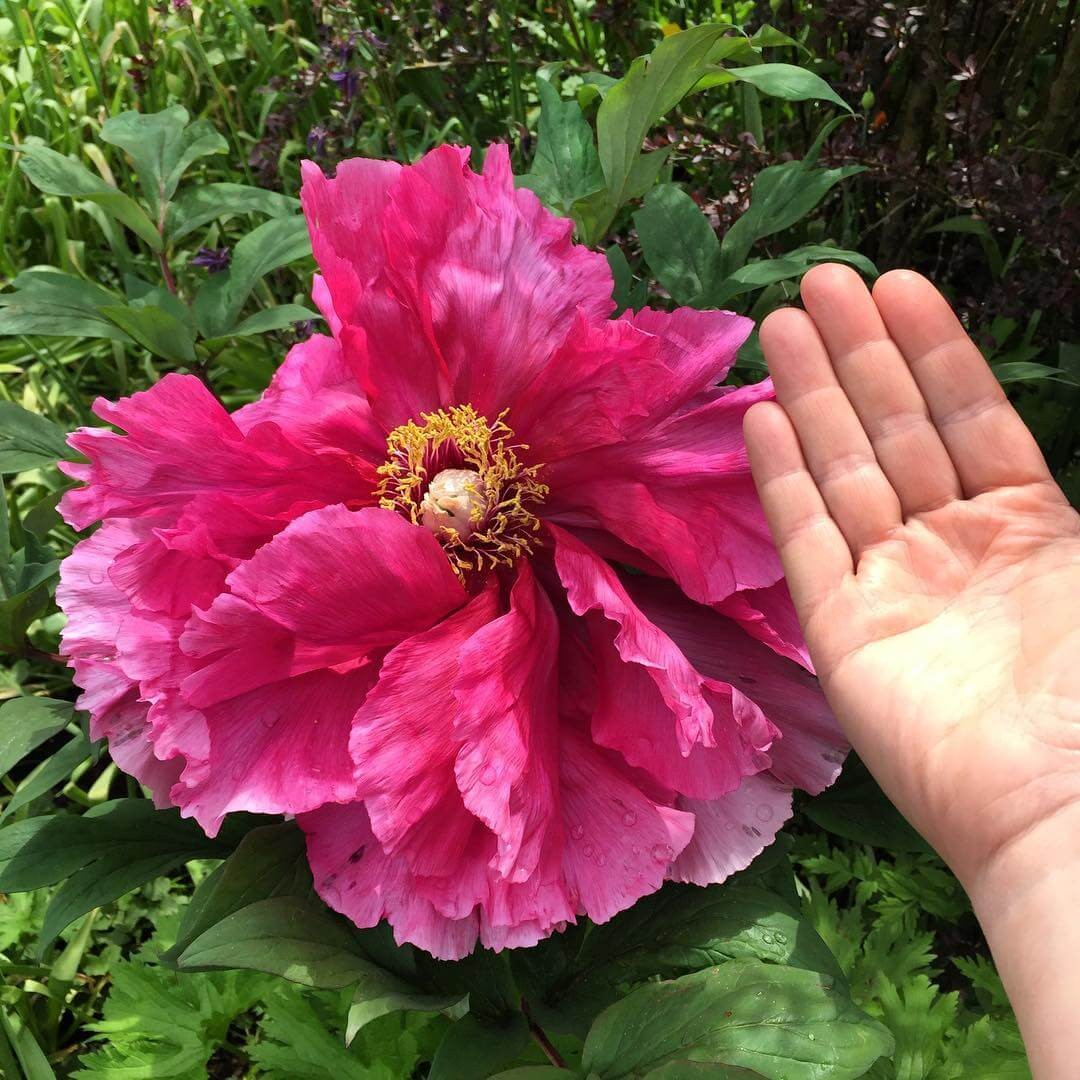
While it may be considered a late bloomer, this plant’s beauty is consistent throughout the year, even after its stunning flowers have reached their peak. Its vibrant, pink-red blooms are particularly striking, featuring bright red stems and stalks that add to their allure. The large, double-petaled flowers are a sight to behold, making this plant a standout in any garden or arrangement.
Tree Peony ‘Gessekai’ (Paeonia suffruticosa Kingdom of the Moon)

One of the most striking and ephemeral flowers of spring is the [insert flower name], a delicate marvel that bursts forth with a singular beauty. Its pure white petals are adorned by a radiant golden yellow stamen at its center, imbuing it with an otherworldly allure. As dusk approaches, this enchanting bloom seems to radiate a soft, ethereal glow, as if infused with the magic of the setting sun.
Tree Peony ‘Hanakisoi’ (Floral Rivaly, Paeonia suffruticosa ‘Hanakisoi’)

The ‘Floral Rivalry’ is renowned for its striking characteristic – large, delicate petals with a unique crepe paper-like texture and appearance. While the overall hue is a soft blush, a subtle yet captivating darker pink undertone adds depth to the flower’s center.
Tree Peony ‘Impumon’

The Peony’s vibrant display of double flowers is unmistakable, with its striking crimson red blooms taking center stage in mid-spring. Nicknamed the True Red, this showstopper adds a pop of color to any perennial garden, making it a fresh and exciting addition.
Tree Peony ‘Sakura Rashidi’

This variety’s appearance is reminiscent of large cherry blossoms, boasting a distinctively shaped bloom characterized by undulating, crinkled edges. The flower’s white-tipped extremities gradually transition to shades of pink as they reach the center, creating a visually striking contrast.
Tree Peony ‘Souvenir de Maxime Cornu’

The stunning bloom boasts a vibrant peach hue, accented by distinctive reddish tints along its edges. A delicate pale yellow core serves as the centerpiece of this visually striking flower. Its frilly edges and rose-like appearance make it an excellent companion for pairing with darker-hued flowers.
Tree Peony ‘Gauguin’

One of the most striking aspects of this tree peony is its bold and vibrant color palette. The large, veined petals boast a bright pink hue with subtle yellow undertones, giving the appearance of a semi-double, crumpled flower. This unique combination was aptly named after the renowned French painter Paul Gaugin by breeder Nassos Daphnis.
Tree Peony ‘Pluto’

Daphnis’ latest creation, this tree peony bears the name of Pluto, the Roman deity of the underworld, due to its striking combination of dark burgundy petals and yellow anthers nestled on a black base. As the light catches it, the flower transforms into a radiant spectacle, as if infused with an otherworldly glow.
Tree Peony ‘Reine Elizabeth’
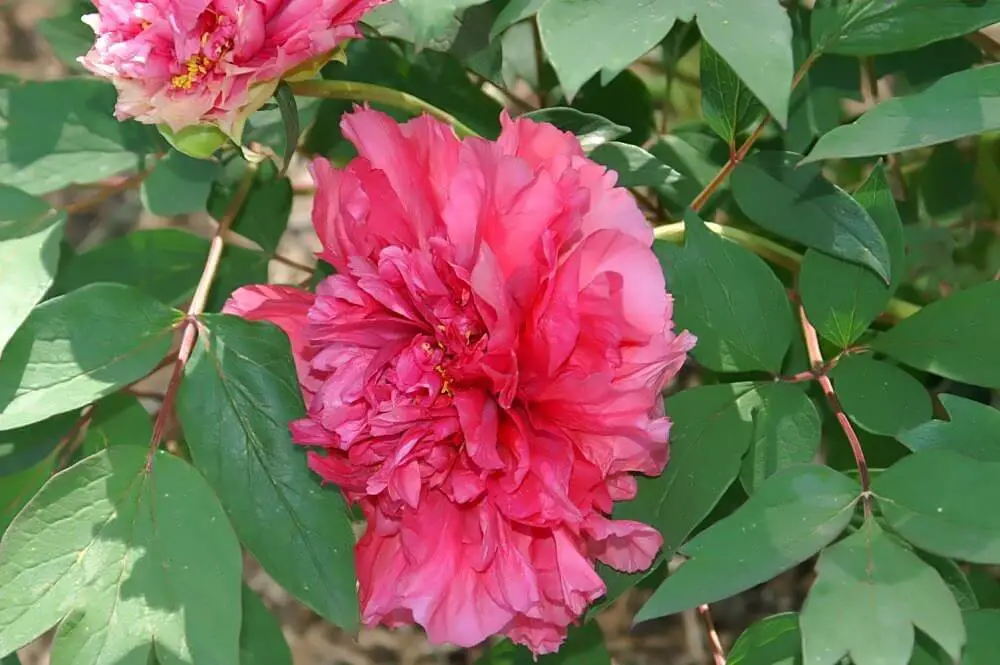
The majestic tree peony boasts a charming vintage charm, characterized by its showy blooms featuring large, double-petaled flowers with ruffled, pink hues that subtly shift towards warm oranges. This classic cultivar demands a protected environment to thrive, as it can be somewhat fragile.
Tree Peony ‘Shimane Sedai’

At first glance, this flower bears a striking resemblance to a rose, but its unique shape sets it apart. The delicate, crepe paper-like petals are a soft baby pink color with intricate ruffled edges that will become even more pronounced as the bloom matures. As the flower reaches full maturity, these ruffles will unfurl into a beautiful double bloom, showcasing the true beauty of this extraordinary rose.
Tree Peony ‘Shima Nishiki’

This stunning peony boasts a striking bicolor palette, with delicate white hues blending seamlessly into rich, deep pink tones. As a sought-after cut flower, it’s particularly prized for its semi-double petals and vibrant golden yellow anthers, which add a warm, sunny touch to any arrangement.
Tree Peony ‘Showano Hokori’
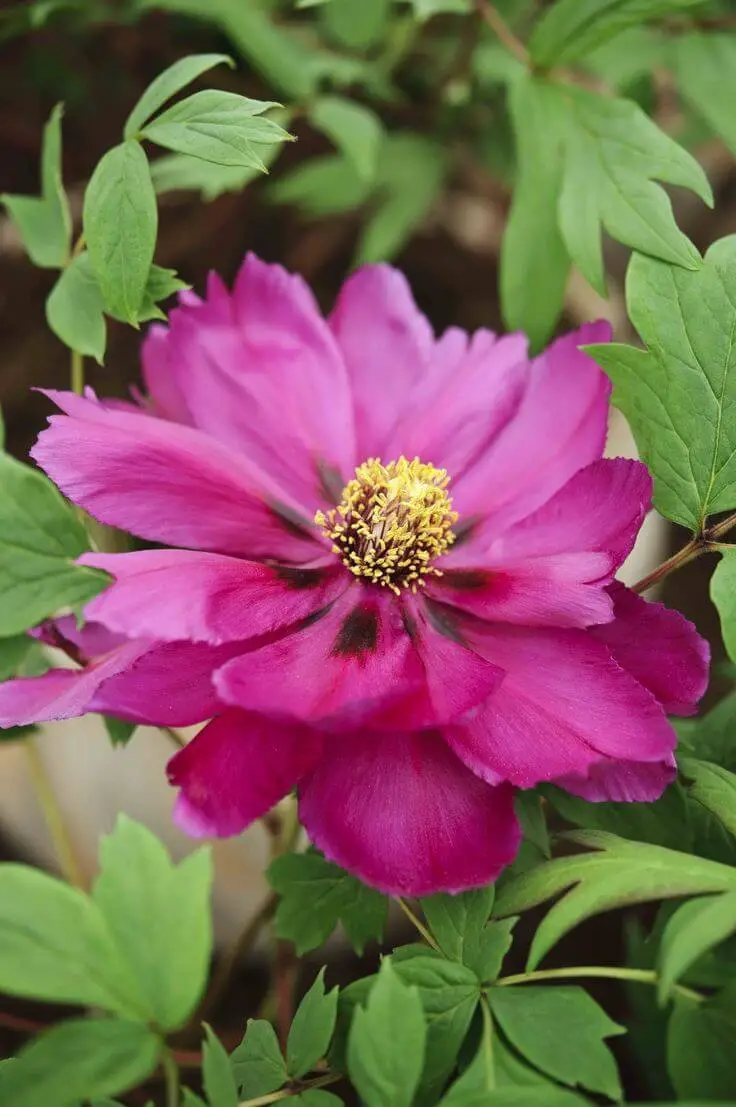
This stunning tree peony boasts vibrant, deep pink blooms adorned with striking black markings and radiant yellow anthers. The semi-double petals curve inward, creating a unique and captivating appearance.
Tree Peony ‘Thunderbolt’
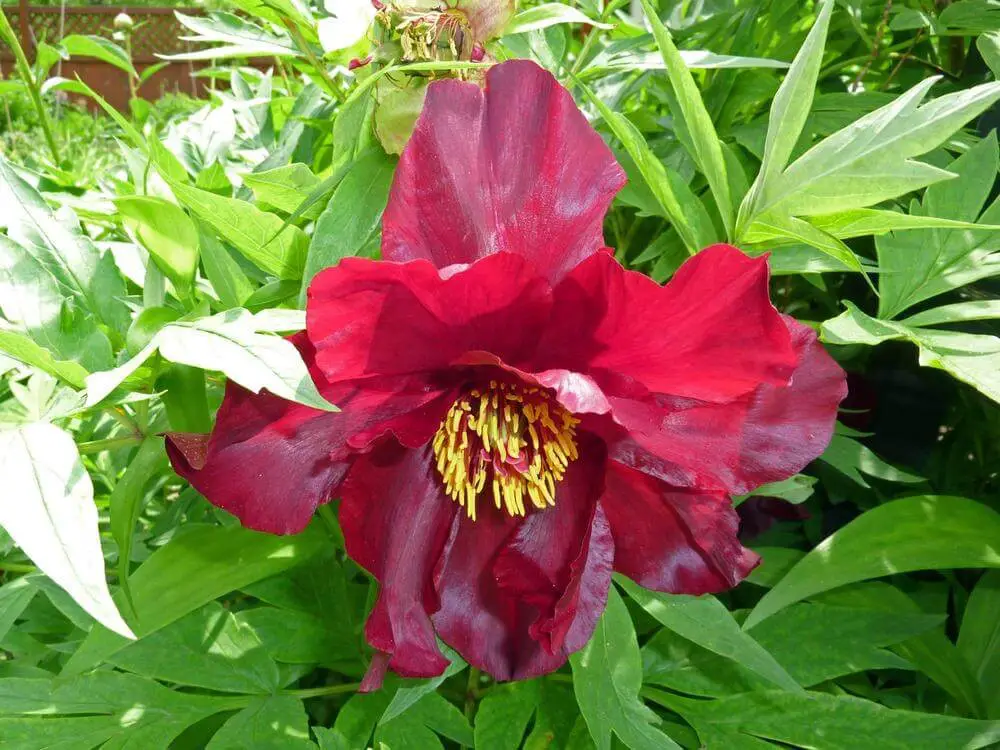
While sometimes mistaken for the Black Pirate due to their shared flower hue, the distinctive characteristic that sets this plant apart is its more diminutive burgundy blooms and uniquely erect stem profile. In contrast to the Black Pirate’s larger flowers and sprawling stems, this variety boasts a compact yet striking appearance.
Herbaceous Peonies
What are Herbaceous Peonies?
Peonies are renowned for their resilience, offering vibrant displays of spring and summer blooms that bring beauty and life to the garden. Also known as Chinese peony or common peony, these annuals boast an array of show-stopping flowers in a range of captivating colors. One of their most impressive attributes is their deer-resistance, making them a reliable choice for gardeners seeking low-maintenance yet visually stunning additions to their outdoor spaces.
Furthermore, they are generally hardy, thriving in a variety of environments.
Facts about Herbaceous Peonies
Herbaceous peonies are a staple in the world of floristry, commonly used in arrangements and bouquets due to their striking appearance. But there’s more to these lovely flowers than meets the eye. For instance, they exhibit a unique characteristic by dying back below ground level before producing vibrant shoots every spring. The flowers themselves are characterized by their silky texture and range of colors including pink, blush, and coral hues.
With proper planting and establishment, herbaceous peonies can provide months of blooming beauty, making them a popular choice among gardeners and floral enthusiasts alike.
Peony ‘Pink Hawaiian Coral’
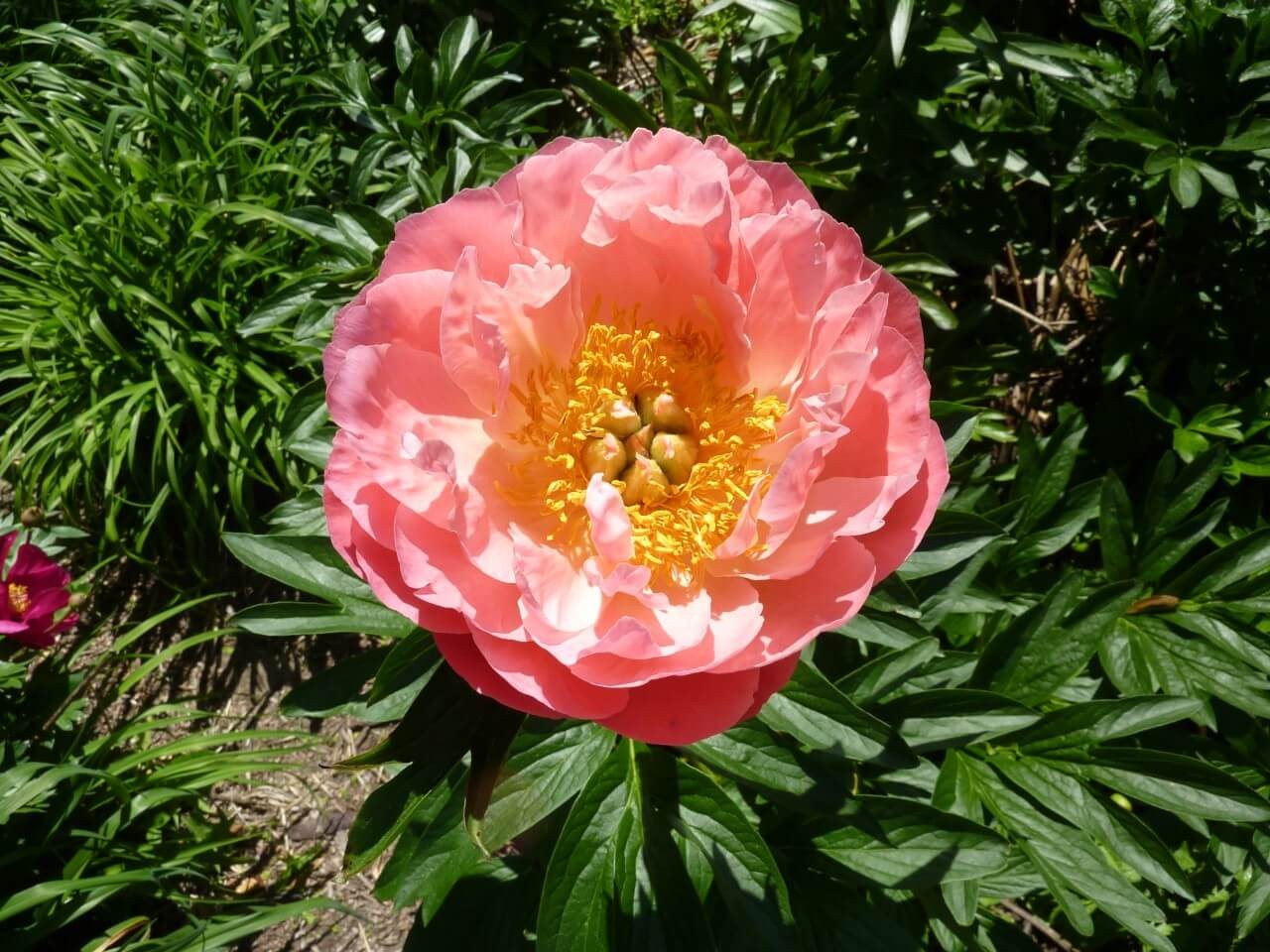
The Hawaiian coral is characterized by its rounded shape and vibrant color palette, featuring soft hues of pale yellow, baby pink, and white. This striking combination earns it its distinctive name. One of the most notable features of this coral is its ability to bloom throughout the entire spring season.
Peony ‘Lady Alexandra Duff’

This stunning variety boasts a showy, rose-shaped bloom that’s truly one-of-a-kind. The delicate, full double flower features pale pink edges and deeper pink ruffled petals that unfold in a breathtaking display. As the seasons change, this beauty blooms profusely during late spring, filling the air with its vibrant colors. But its charm doesn’t stop there – the lacy foliage remains attractive and intact through winter, providing year-round interest.
Peony ‘Sword Dance’

The Paeonia veitchii, commonly known as the ‘Festiva Maxima’, earns its reputation with its whimsical, curly anthers that appear to dance in every direction. Its striking features include large, vibrant magenta flowers and anthers that transition from red to purple to yellow. What sets this peony apart is its remarkable resilience to wind and its extended blooming period of at least six weeks, making it a highly sought-after variety among gardeners.
Peony ‘Elsa Sass’

This rare and exquisite flower boasts an appearance reminiscent of delicate crepe paper. Its striking feature is a large, double-flowered bloom with silky, pure white petals that unfurl like intricate silk fabric. While small, yellow stamens are present, they are often obscured by the flower’s ruffled texture, adding to its ethereal charm.
Itoh Peonies
What are Itoh Peonies?
Hybrid peonies known as Itoh or intersectional peonies, derive their name from their Japanese parent. Characterized by a blend of sturdiness from herbaceous peonies and the vibrant colors reminiscent of tree peonies, these varieties excel in their unique combination of traits. In addition to their striking hues, Itoh peonies also boast attractive foliage that persists from summer through fall, before disappearing with the onset of winter.
How many varieties of Itoh peonies are there?
With over 46 recognized varieties, Itoh peonies have made a significant impact on the world of gardening. The journey to create these stunning flowers began in 1948 when the first Itoh peony variety was born after thousands of attempts at cross-breeding herbaceous and tree peonies. What sets Itoh peonies apart is their extensive color palette, featuring not only single-colored blooms but also the rare bicolored varieties.
Peony ‘Bartzella’
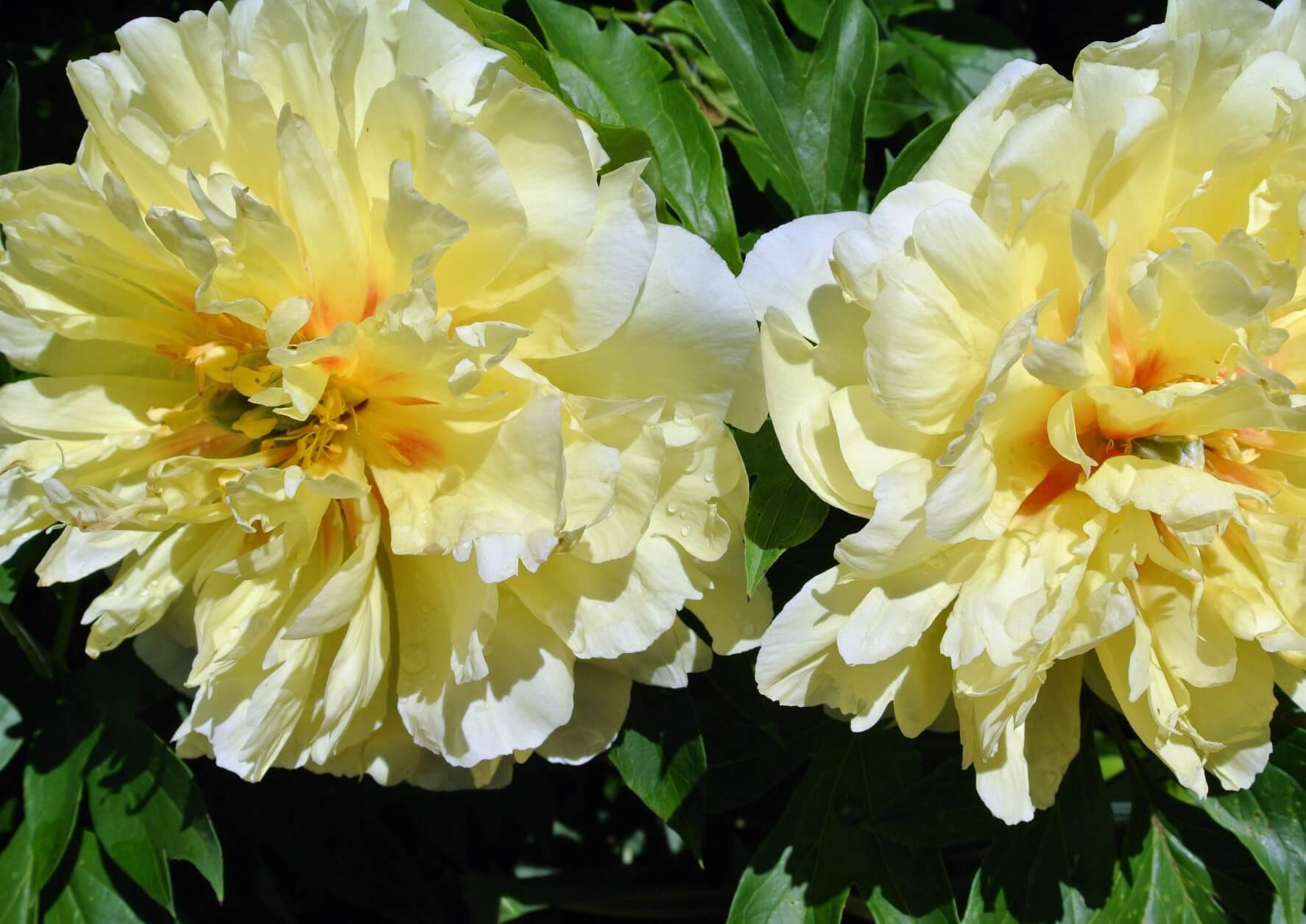
The Peony’s Vibrant Hue and Lush Bloom: A Consistent Award-Winner
This stunning variety boasts a radiant, lemon-yellow color that truly catches the eye. Its rapid growth rate and prolific blooming habits make it a standout among peonies.
Not only does it showcase an elegant crepe paper-like appearance, but its semi-double flowers also grow upright, adding to its overall charm.
As if these attributes weren’t enough, this peony has earned a consistent horticultural award for its exceptional qualities, making it a must-have for any garden enthusiast.
Peony ‘Cora Louise’

The striking blooms of this variety boast large, pure white petals that form semi-double flowers. A stunning contrast is created by the dark red hearts at their center, which are surrounded by golden yellow anthers and a subtle pink base. Notably, this cultivar is celebrated for its prolonged flowering period, with blooms persisting from late spring through mid-fall.
Peony ‘First Arrival’

The ‘earliest Itoh bloomer’ boasts an impressive array of characteristics that set it apart from its peers. Its exceptional drought tolerance is matched only by the strength of its stems, which provide a sturdy foundation for the plant’s showy display. The real pièce de résistance, however, lies in the flowers themselves – medium-sized, delicate and papery, they burst forth in a kaleidoscope of white, lavender, and purple hues, a testament to the plant’s remarkable longevity.
Peony ‘Garden Treasure’

The Itoh variety stands out as one of the most celebrated and multi-award-winning among its peers. Its crowning glory is its majestic, semi-double bloom featuring at least 50 petals that radiate a warm golden-yellow hue. The central hub of the flower boasts a striking red-brown coloration, adding to its visual appeal. This prized specimen boasts sturdy stems that support an abundance of blooms from late spring to early summer.
As if this weren’t enough, the Itoh variety also emits a powerful lemon scent, further enhancing its allure.
Peony ‘Julia Rose’

This striking Itoh orchid boasts a unique feature – its flowers change color during the blooming process, offering a dynamic display over time. The initial blooms often start with vibrant hues of orange, apricot, or red, featuring creamy yellow edges that add an extra layer of visual interest. As the blooms mature, they gradually shift to a bright and cheerful shade of yellow, creating a stunning floral arrangement.
Additionally, this Itoh orchid is distinguished by its sweet and spicy fragrance, further enhancing its appeal.
Peony ‘Prairie Charm’

This particular peony variety has earned a reputation for its remarkable durability, along with a delicate yet pleasing scent. Its versatility also makes it an ideal choice for adding a pop of color to garden borders and creating stunning arrangements. The blooms are characterized by their semi-double, upright shape, and impressive size, showcasing a beautiful shade of yellow with a striking red undertone.
Peony ‘Singing in the Rain’

The ‘Luminous Apricot’ rose boasts an extraordinary appearance, characterized by large, semi-double flowers that shimmer with a subtle transparency. The blooms unfold in a vibrant apricot and salmon hue, featuring curved petals and delicate, whimsical stamens that stretch towards the sky. What sets this variety apart is its unique coloration – the stamens display a striking combination of yellowish-white and orange-green tones at their base.
This rose is a prolific bloomer, ensuring a constant display of beauty throughout the growing season. Furthermore, it boasts deep green foliage that maintains its vibrancy even during the cold winter months, providing year-round interest in the garden.
Rare peony varieties
While there are many varieties of peonies, a small but notable subset consists of rare and unique cultivars. These can include Itoh peonies, as well as herbaceous peonies that have been bred to possess distinct characteristics. Additionally, some rare peonies may result from over-breeding, where the parent plant is lost in the process.
For those interested in collecting or growing these unusual varieties, here are some notable examples: Cora Louise, Angela Jo, Bernice Carr, Bravura, Cardinal’s Robe, Dark Promise, Edna’s Wish, Elise McKenna, Faithful Dream, Frances Mains, Francois Ortegat, Gordon E. Simonson, John Howard Wigell, Kathy’s Touch, Kayleigh Ann, Magic Moonbeam, New Dimension, and Sonoma Welcome.
Bloom Types for Peonies
Single peonies
A staple among peony enthusiasts, Imperial peonies stand out with their unique appearance, characterized by a distinctive arrangement of petals. At its core, this variety features a cluster of at least five guard petals that carefully encase the vital pollen, a striking feature that sets it apart from other types of peonies.
Semi-double peonies
These flowers are characterized by their stunning appearance, even when not yet fully bloomed. As they unfurl, they can transform into majestic full-doubles, showcasing intricate details. Prior to this, they already display artistic merit through their large, showy petals and prominent stamens. One of the notable features is the presence of multiple rows of petals, which are often accompanied by visible anthers, adding texture and depth to the overall visual effect.
Japanese peonies
A unique characteristic of these peonies is their propensity for doubling, resulting in intricate patterns featuring multiple layers of petals. Furthermore, they boast bright yellow anthers that contain vital pollen. Interestingly, while not native to Japan, the Japanese have developed a strong affinity for these flowers and often associate them with high social standing.
Anemone peonies
The resemblance to Japanese peonies is striking, except for one notable difference: the absence of anthers. Instead, the stamens resemble incurved petals, adding a unique touch to their overall appearance. Some specimens also exhibit a side-blooming habit, further diversifying their visual presentation.
Full-double peonies
Beyond the initial layer of petals, a secondary covering of flowers adorns the plant’s crown. Notably, these additional blooms lack any discernible reproductive structures like stamens or anthers. However, their guard petals are highly developed, contributing to the rounded appearance of the overall structure.
The bomb peony
The bomb peonies stand out due to their distinct globular appearance, accompanied by shorter guard petals that contribute to this unique visual profile. In addition, these flowers lack visible pollen and anthers, taking on a more sculpted form as time passes, ultimately resembling a bulky, ball-like shape. A notable example of this type of peony is the Raspberry Sundae variety.
Peonies care
While peonies are generally low-maintenance, they still require some attention to thrive. Here’s a rundown of the essential care tips you need to keep in mind:
Digging and dividing
One of the unique advantages of peonies is their ability to flourish even when neglected. Unlike many other perennials that require regular maintenance, such as digging and dividing, to encourage optimal blooming, peonies can thrive without these efforts. This means you won’t need to dedicate time or resources to ensure a bountiful bloom the following year.
Watering
Peonies thrive in areas that receive full sun, yet their delicate petals rely on consistent moisture to flourish. To ensure optimal growth, it’s crucial to provide them with thorough and frequent watering sessions, aiming for at least one inch of water per week, ideally distributed evenly throughout the seven days.
Fertilizer
When it comes to maintaining the optimal level of moisture for your peonies, applying a layer of organic mulch during the spring season is crucial. However, it’s equally important to remove this mulch before winter sets in. A 5-10cm thick layer is ideal for these flowers, providing the necessary protection and hydration throughout the growing period.
Staking
Specifically, this guideline pertains to herbaceous and Itoh peonies, where certain cultivars exhibit an natural inclination towards arching growth patterns. As a result, some varieties may necessitate the use of stakes to ensure optimal plant structure and stability.
Cutting
To ensure a healthy start to the next growing season, it’s crucial to provide end-of-season care for your peonies in the fall. One essential step is to undertake this process before the onset of winter, as this helps prevent pests from overwintering and reduces the likelihood of common diseases emerging.
What is the difference between peonies and tree peonies?
While discussing peonies, we’re specifically focusing on herbaceous and Itoh varieties. One of the most notable distinctions between these types and tree peonies is the way they approach leaf growth. Herbaceous and Itoh peonies produce rounded leaves in mounds during spring and summer, with these leaves transforming as they begin to die back in the fall. In contrast, tree peonies don’t experience a dramatic color change; instead, their leaves simply shed when the season turns.
Furthermore, herbaceous and Itoh peonies require their stems to be cut annually, whereas tree peonies boast woody stems that remain sturdy year-round.
Which peony blooms the longest?
When it comes to the duration of their blooms, herbaceous peonies stand out from the crowd. On average, they put on a show for around three to four weeks, with some varieties lasting even longer. In contrast, other types of peonies tend to bloom throughout the spring and into mid-summer, providing a prolonged period of color and beauty. Meanwhile, tree peonies, although impressive in size, have a relatively short blooming period, typically lasting around 10 days at most.
What are the most fragrant peonies?
In terms of fragrance, peonies exhibit a fascinating phenomenon – their scent is directly linked to their color. This peculiarity is particularly significant in the perfume industry, where selecting the right peony varieties with notable fragrances can make all the difference. Among the numerous species of peonies, pink and white ones are generally considered the most aromatic, while red varieties, such as some others, lack a distinct scent altogether.
Double-flowered (semi-double and full double) peonies also fall into the fragrant category. Notably, some of the most highly scented peony varieties include Henry Bockstoce, Duchesse De Nemours, Cora Stubbs, Philomele, and Hermione. While there are many moderately scented peonies to explore, it’s worth highlighting that Burma Ruby, Bratzella, Garden Treasure, Pink Derby, Pink Hawaiian Coral, Honey Gold, and Mary Mayshine stand out as particularly notable for their fragrance.
Conclusion
Beyond their stunning appearance, peonies have a profound botanical heritage, historical and symbolic significance, and a vast universe of varieties. With a rich history spanning hundreds of years, they’ve earned a special place in the hearts of gardeners worldwide. The three major types of peonies only add to their allure, making it no surprise that they’re widely regarded as one of the most beloved flowers.
Related Posts
When considering the etiquette surrounding flower delivery, a common question arises: do you tip your floral courier? The answer lies in understanding the role of gratuities in this industry. As with any service-based profession, tipping is not only appreciated but also expected to some extent. For instance, florists who deliver bouquets and arrangements often rely on these tips to supplement their income.
In fact, a standard tip for flower delivery typically ranges from 10% to 15% of the total order cost. However, it’s essential to remember that gratuities are entirely discretionary, so you should only provide one if you’re satisfied with the service received. That being said, it’s always a thoughtful gesture to show appreciation for your courier’s efforts in bringing joy and beauty to someone’s life.

